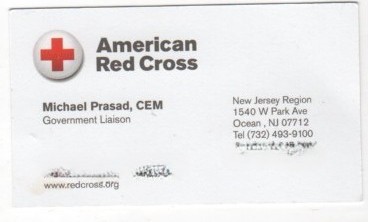16 Today – 2025
This year (2025) was very interesting as far as Emergency Management in the United States goes.
I will note that the American Red Cross (and the global Red Cross/Red Crescent movement) was around well before FEMA and will still be around well after FEMA.
For me, I am now:
- Volunteering with the IAEM, leading from the front,
- Volunteering with the Red Cross, leading from the middle,
- Volunteering with the NJVOAD, also leading from the front once again,
- Volunteering with the IMTA, as a member of two committees (Intelligence and Investigation and Planning) and one task force (certifications)
- Doing pro bono advocacy work on pediatric feeding (see green box below) and other projects I get to choose
- Writing, Writing, and more Writing
- Teaching
- Consulting (and trying to pay the bills)

I will also note there are a ton of quotes out there to help elevate your own thinking about the role of government and the people – and how we have to be self-sustaining – sometimes even in spite of what our government is doing (or doing against us). I do like this quote[1] from President Franklin D. Roosevelt, from 1944:
The creed of our democracy is that liberty is acquired and kept by men and women who are strong and self-reliant, and possessed of such wisdom as God gives mankind – men and women who are just, and understanding, and generous to others — men and women who are capable of disciplining themselves. For they are the rulers and they must rule themselves.
One of the aspects of meta-leadership I have gained, is the ability to make effective changes in other organizations. I am in the middle of a long-term national Emergency Management project, which started when a disaster researcher came to the IAEM-USA Children and Disaster Caucus and gave her doctoral dissertation pitch. The project is to fix the way we (Emergency Managers) support families in disasters – during the Response phase – with their choice for feeding their infants and toddlers. Rather than devoting pages here in this book – and since a good chunk of it has already been published elsewhere, where I do not hold the copyright – here’s a link to where you can find all that, online. If you are reading this in print, put down the book, and start typing on your phone, laptop or tablet – https://bartondunant.com/pediatric-feeding
We were successful in changing FEMA and their public policies/procedures (for what it’s worth – now, at the time of writing this, the U.S. White House is contemplating dissolving FEMA, so much of this may be moot in the future) to the benefit of kids. Little kids – think infants and toddlers. Working on the various states, territories, tribal nations and big cities next…
Breaking down the parts
Pracademic – works best for change management where organizational practices need to be modified/altered, with the foundational reasoning for this to be researched from a scientific process. So, change solely for economic benefit is not pracademic
Outsider– not in the chain of command or leadership of an organization. May be a politician, media, subject-matter-expert, academic, ordinary citizen, Cassandra[1], etc.
Insider – someone who is – or was – in the chain of command or leadership of an organization. This theory requires a team effort – with both outsiders and insiders, but the point of this theory is that the insider does not have the power to make the change solely on their own or even with other insiders. These are generally not whistleblowers. But they can be. Challenger O Ring example of the insider only change.
Change Management – Fixing large scale problems – or widely implement small scale fixes. The benefits should also align with social and environmental justice. No point in fixing one problem by generating or amplifying another.
Works on Black Swans, Grey Rhinos, Polycrises, and more. Helps Cassandras be acknowledged and believed.
[1] Warnings is the story of the future of national security, threatening technologies, the U.S. economy, and possibly the fate of civilization.
In Greek mythology Cassandra foresaw calamities but was cursed by the gods to be ignored. Modern-day Cassandras clearly predicted the disasters of Katrina, Fukushima, the Great Recession, the rise of ISIS, the spread of viruses and many more. Like the mythological Cassandra, they were ignored. There are others right now warning of impending disasters—from cyber-attacks to pandemics—but how do we know which warnings are likely to be right?
Through riveting explorations in a variety of fields, the authors—both accomplished CEOs and White House National Security Council veterans—discover a method to separate the accurate Cassandras from the crazy doomsayers. They then investigate the experts who today are warning of future disasters: the threats from artificial intelligence, biohacking, malware attacks, and more, and whose calls are not being heeded. Both Clarke’s and Eddy’s penetrating insights are essential for any person, any business, or any government that doesn’t want to be a blind victim of tomorrow’s catastrophe.
Denning, S. (2010), “A leader’s guide to radical management of continuous innovation”, Strategy & Leadership, Vol. 38 No. 4, pp. 11-16. https://doi.org/10.1108/10878571011059692
- https://www.presidency.ucsb.edu/documents/address-soldiers-field-chicago-illinois ↵
International Association of Emergency Managers
New Jersey Voluntary Organizations Active in Disaster
Incident Management Team Association
